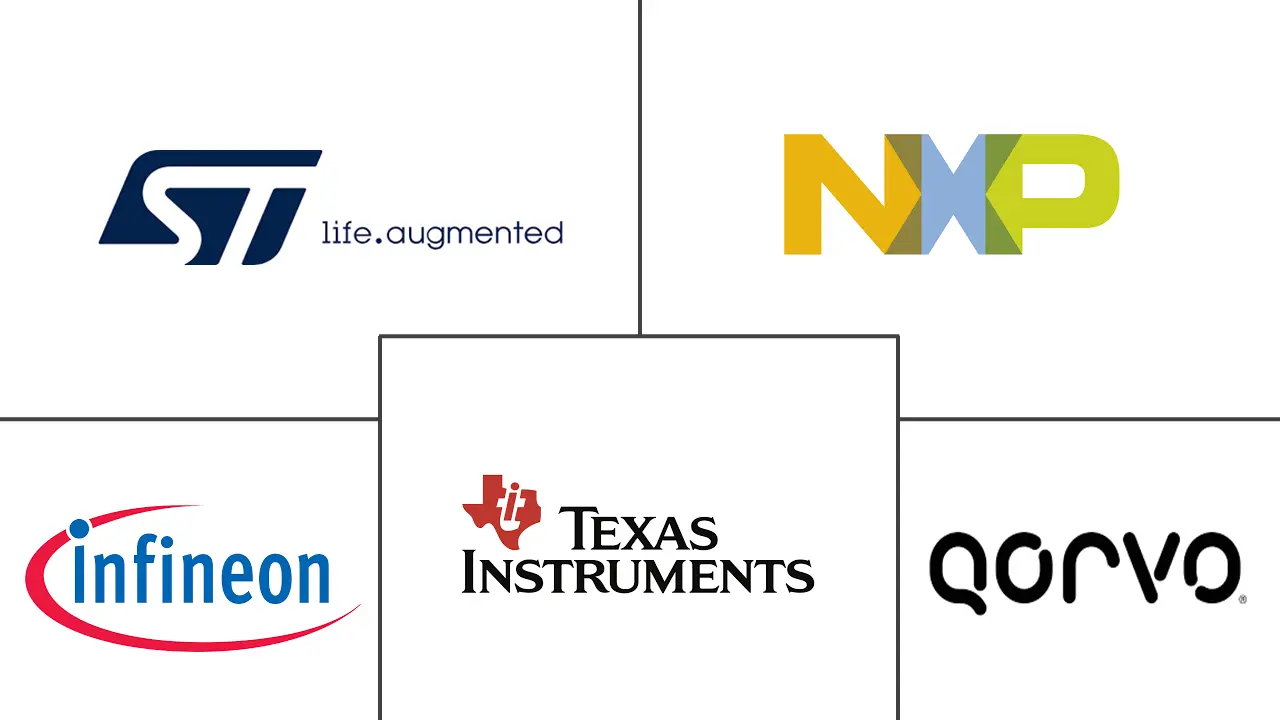Power Semiconductor Market Size
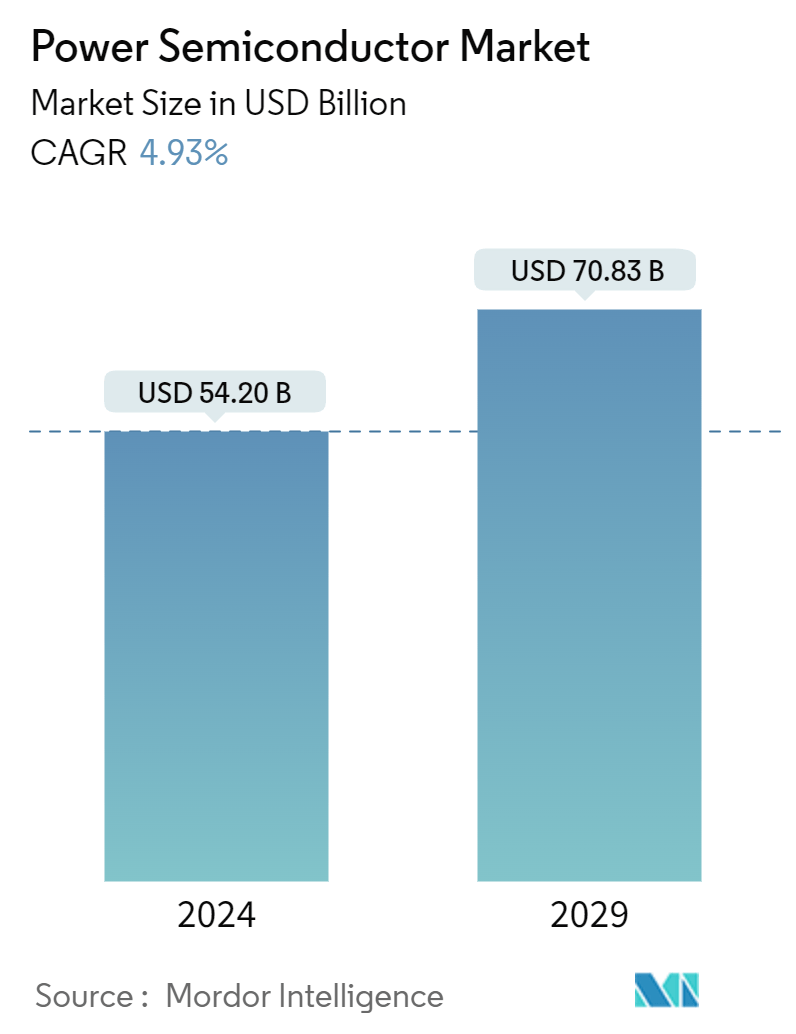
| Study Period | 2019 - 2029 |
| Market Size (2024) | USD 54.20 Billion |
| Market Size (2029) | USD 70.83 Billion |
| CAGR (2024 - 2029) | 4.93 % |
| Fastest Growing Market | Asia |
| Largest Market | Asia |
Major Players*Disclaimer: Major Players sorted in no particular order |
Power Semiconductor Market Analysis
The Power Semiconductor Market size is estimated at USD 54.20 billion in 2024, and is expected to reach USD 70.83 billion by 2029, growing at a CAGR of 4.93% during the forecast period (2024-2029).
Power semiconductors are designed to handle or process large currents and power, and they are typically categorized as having a rated current of 1A or greater. These devices are used in a wide range of applications, including home appliances, audiovisual equipment, automobiles, etc.
• Power semiconductors have revolutionized the field of electronics and energy management. One of the key advantages of power semiconductors is their ability to improve energy efficiency significantly. By minimizing energy losses during the conversion and control processes, power semiconductors enable systems to operate more efficiently, reducing energy consumption and saving costs. These devices offer higher power density, lower on-resistance, and reduced switching losses, resulting in higher overall system efficiency.
• Moreover, power semiconductors offer higher power density, allowing more power to be handled within a smaller physical footprint, which is beneficial in applications where space is limited, such as electric vehicles and industrial automation. Power semiconductors enable the development of compact and efficient systems by maximizing power output while minimizing space requirements.
• Rapid technological advancement is one of the primary drivers of the surging demand for consumer electronics and wireless communication. The continuous evolution of technology has led to the introduction of innovative and feature-rich devices that have revolutionized the way an individual interacts with the world. Smarter smartphones, ultra-slim laptops, high-definition televisions, and wearable gadgets have become essential tools for both personal and professional purposes. These advancements have enhanced the user experience and contributed to the increasing demand for such devices.
• Silicon wafers are the foundation of power semiconductor manufacturing. These thin, circular discs of crystalline silicon serve as the substrate upon which semiconductor devices are built. Silicon's unique properties, such as its abundance, high thermal conductivity, and excellent electrical properties, make it an ideal material for these applications. The power semiconductor market heavily relies on silicon wafers due to their suitability for high-power applications.
• According to the US Congressional Budget Office, defense spending in the United States is predicted to increase every year until 2033. Defense outlays in the United States amounted to USD 746 billion in 2023. The forecast predicts an increase in defense outlays up to USD 1.1 trillion in 2033. The defense spending would comprise 6% of the country's gross domestic product in 2024, up from 3.9% in 2023 and 2.7% in 2021. The increasing defense budgets globally are expected to offer lucrative opportunities for the growth of the market studied.
Power Semiconductor Market Trends
Automotive Industry to be the Fastest Growing End User
- Analyzing power semiconductors in the automotive segment includes ADAS for adaptive cruise control, lane assistance, collision avoidance, infotainment systems for smooth music playback and accurate GPS functionality, telematics and connected vehicles, and others. Furthermore, they are also used in electric vehicles to coordinate the operations of electric motors.
- Automotive is one of the emerging sectors of the power semiconductors market and is estimated to have a significant share with the increase in the adoption of autonomous vehicles, EVs, and HEVs.
- Power electronics is widely utilized in automotive electrical and electronic systems to enhance fuel efficiency and address thermal concerns. This is achieved by implementing components like silicon-based power MOSFETs and IGBTs, which serve as power electronic switches in the power train system. By employing these technologies, the system's overall size can be reduced while utilizing high power in the kilowatt range.
- Moreover, the Insulated Gate Bipolar Transistor (IGBT) has emerged as an essential component in the development of electric vehicles. In the upcoming years, it is anticipated that the demand for IGBTs will rise significantly due to the rise in EV sales. For instance, according to a recent report from the International Energy Agency, electric car markets experienced robust growth, with sales approaching 14 million in 2023. The market share of electric vehicles surged from approximately 4% in 2020 to 18% by 2023, indicating a significant shift in consumer preferences toward more sustainable transportation options.
- Electric vehicle sales are poised for robust growth through 2024. In the first quarter alone, global sales of electric cars surpassed 3 million, marking a 25% surge compared to 2023. Forecasts suggest a total of approximately 17 million electric vehicles will be sold by the close of 2024, indicating a notable 20%+ year-on-year uptick, with a significant acceleration in new purchases anticipated in the latter half of this year. This surge is largely attributed to a combination of national policies, incentives, and intensifying price competition, all working in tandem to bolster sales and drive the market forward.
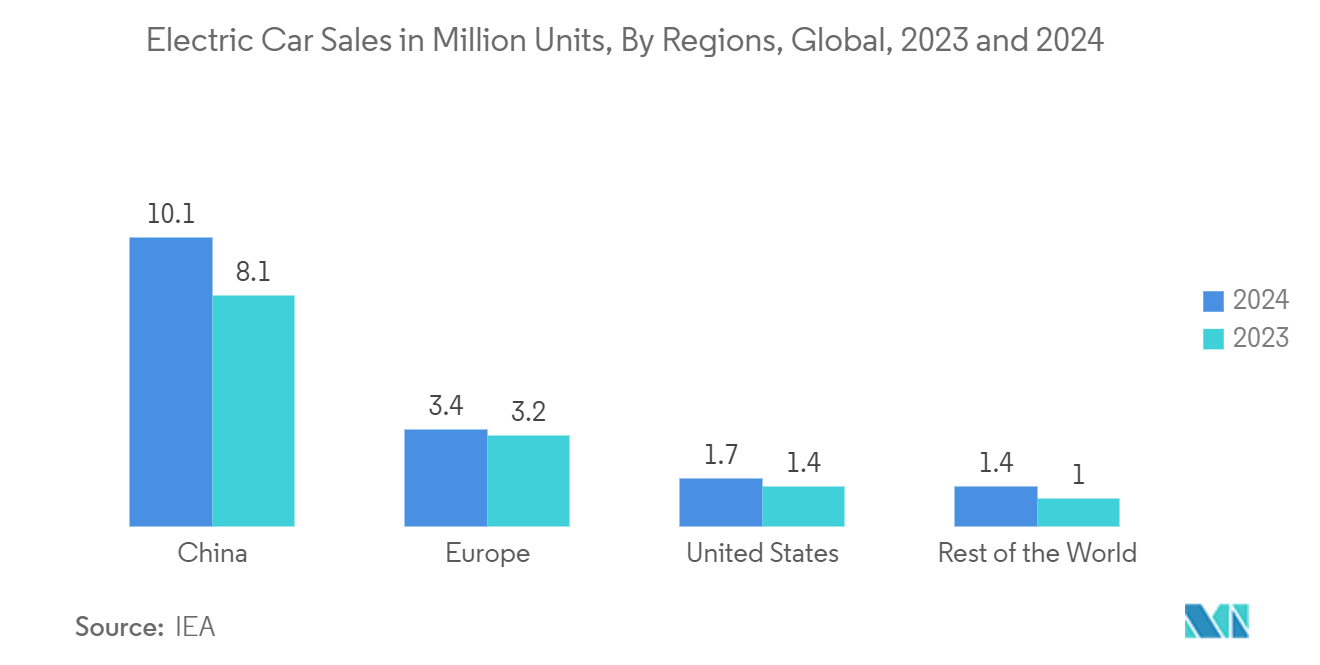
China to Witness Major Growth
- Power semiconductors are increasingly prevalent in EVs, as these vehicles demand high-power energy for their electric motors. Components like MOSFETs and IGBT serve as power electronic switches in the vehicles' power train systems. The market's notable growth is fueled by the escalating demand for energy-efficient hybrid electric vehicles, particularly in nations like China, as they combat the effects of mounting environmental pollution.
- Notably, China stands as the world's premier vehicle market, boasting the highest annual sales and manufacturing output. By 2025, the nation is expected to be on track to achieve a significant milestone, with an estimated 35 million vehicles slated for domestic production.
- Looking ahead, as China aims for carbon neutrality by 2060, the government's initiatives are set to bolster the demand for power electronics. This push aligns with the broader market expansion, especially in the electric vehicle segment. China's Development Plan for the New Energy Automobile Industry (2021-2035) projects that EVs could capture a 25% market share by 2025. Consequently, China is intensifying efforts to incentivize EV purchases, a move expected to further propel the development and adoption of power electronics in the EV landscape.
- In collaboration with its government, China made substantial progress in expanding its 5G network nationwide. The country's major telecom operators, China Mobile, China Unicom, and China Telecom, led the construction of robust 5G infrastructure in urban centers and key regions. This initiative enabled millions of users to access high-speed, reliable internet services across China. The deployment of base stations has now reached a critical stage.
- By the end of 2023, the number of 5G base stations in China amounted to 3.38 million. With extensive infrastructure investments and ambitious rollout plans, China has achieved significant 5G coverage. According to forecasts, the number of base stations is projected to reach over six million by 2024.
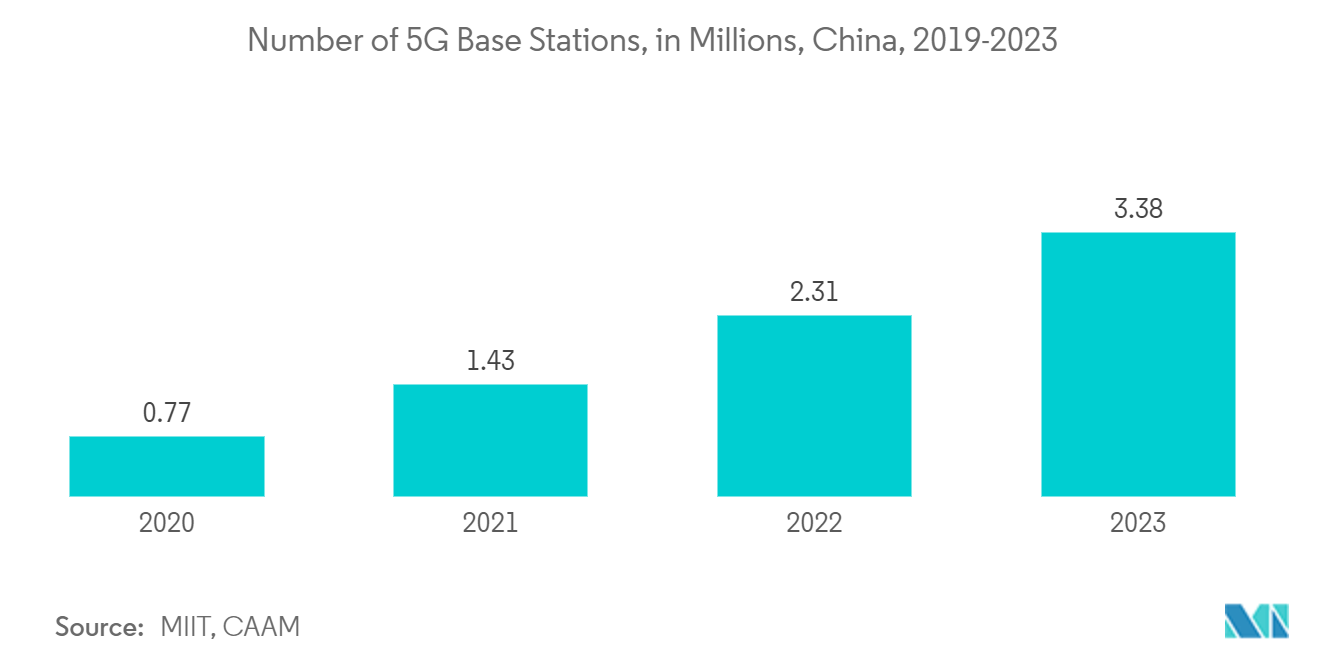
Power Semiconductor Industry Overview
The power semiconductor market is fragmented and comprises several global and popular players, such as Infineon Technologies AG, Texas Instruments Inc., STMicroelectronics NV, NXP Semiconductors NV, Qorvo Inc., and others. Furthermore, in a market where the sustainable competitive advantage through innovation is considerably high, the competition is expected only to increase, considering the anticipated surge in demand from new customers from the end-user industries.
• June 2024 - US semiconductor giant Texas Instruments and Taiwanese electronics expert Delta Electronics joined forces to enhance power electronics for electric vehicles. Their initial focus was on crafting a lighter, more cost-efficient 11 kW onboard charger; this marked just the beginning of their partnership. In the long run, the two firms, TI and Delta, will leverage their joint innovation lab in Pingzhen, Taiwan, pooling their expertise in power management and supply. Their goal is to boost power density, enhance performance, and shrink sizes, all in a bid to hasten the arrival of safer, speedier, and more affordable electric vehicles.
• April 2024 - Infineon Technologies AG partnered with FOXESS, which specializes in inverters and energy storage systems. The collaboration was geared toward advancing green energy initiatives. Infineon's contribution includes supplying FOXESS with its cutting-edge CoolSiC MOSFETs rated at 1,200 V. These will be paired with EiceDRIVER gate drivers, tailored explicitly for industrial energy storage applications.
Power Semiconductor Market Leaders
-
Infineon Technologies AG
-
Texas Instruments Inc.
-
STMicroelectronics NV
-
NXP Semiconductors NV
-
Qorvo Inc.
*Disclaimer: Major Players sorted in no particular order
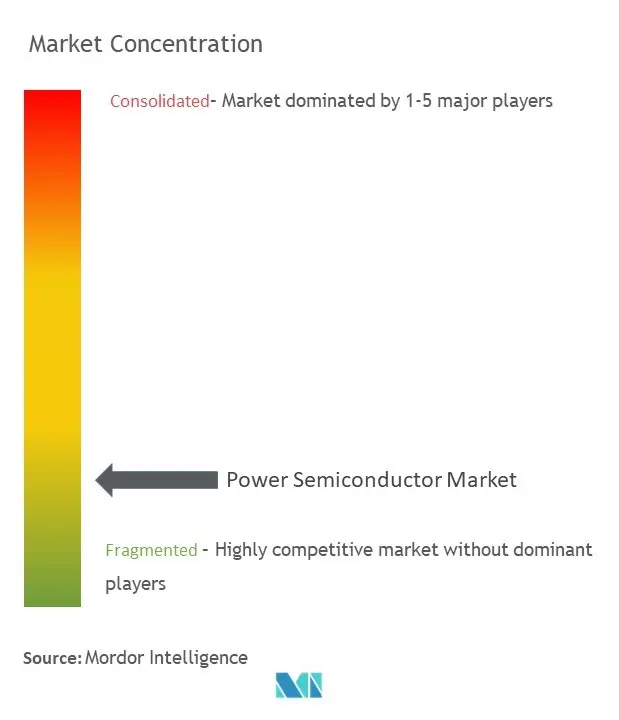
Power Semiconductor Market News
- June 2024 - Infineon Technologies AG unveiled the CoolGaN Transistor 700 V G4 product family. These devices excel in power conversion, specifically in the 700 V voltage range. These transistors boast a 20% performance boost in input and output figures-of-merit. This enhancement translates to heightened efficiency, minimized power losses, and more economical solutions. The applications span from consumer chargers and notebook adapters to data center power supplies, renewable energy inverters, and battery storage solutions.
- June 2024 - Elliott, a USD 65 billion hedge fund renowned for its shareholder activism, injected USD 2.5 billion into Texas Instruments. The fund advocates a more flexible approach to capital expenditures to boost the company's free cash flow. In a detailed 13-page letter obtained by CNBC, Elliott suggested Texas Instruments implement a "dynamic capacity-management strategy." As per Elliott, this strategy could potentially elevate the company's free cash flow to USD 9 per share by 2026.
Power Semiconductor Market Report - Table of Contents
1. INTRODUCTION
- 1.1 Study Assumptions and Market Definition
- 1.2 Scope of the Study
2. RESEARCH METHODOLOGY
3. EXECUTIVE SUMMARY
4. MARKET INSIGHTS
- 4.1 Market Overview
- 4.2 Industry Value Chain/supply Chain Analysis
-
4.3 Industry Attractiveness - Porter's Five Forces Analysis
- 4.3.1 Bargaining Power of Suppliers
- 4.3.2 Bargaining Power of Buyers
- 4.3.3 Threat of New Entrants
- 4.3.4 Intensity of Competitive Rivalry
- 4.3.5 Threat of Substitutes
- 4.4 Impact of COVID-19 Aftereffects and Other Macroeconomic Factors on the Market
- 4.5 Technology Snapshot
5. MARKET DYNAMICS
-
5.1 Market Drivers
- 5.1.1 Increasing Demand for Consumer Electronics and Wireless Communications
- 5.1.2 Growing Demand for Energy-Efficient Battery-powered Portable Devices
-
5.2 Market Restraints
- 5.2.1 Shortage of Silicon Wafers and Variable Driving Requirement
6. MARKET SEGMENTATION
-
6.1 By Component
- 6.1.1 Discrete
- 6.1.1.1 Rectifier
- 6.1.1.2 Bipolar
- 6.1.1.3 MOSFET
- 6.1.1.4 IGBT
- 6.1.1.5 Other Discrete Components (Thyristor and HEMT)
- 6.1.2 Modules
- 6.1.2.1 Thyristor
- 6.1.2.2 IGBT
- 6.1.2.3 MOSFET
- 6.1.3 Power IC
- 6.1.3.1 Multichannel PMICS
- 6.1.3.2 Switching Regulators (AC/DC, DC/DC, Isolated and Non-isolated)
- 6.1.3.3 Linear Regulators
- 6.1.3.4 BMICs
- 6.1.3.5 Other Components
-
6.2 By Material
- 6.2.1 Silicon/Germanium
- 6.2.2 Silicon Carbide (SiC)
- 6.2.3 Gallium Nitride (GaN)
-
6.3 By End-user Industry
- 6.3.1 Automotive
- 6.3.2 Consumer Electronics
- 6.3.3 IT and Telecommunication
- 6.3.4 Military and Aerospace
- 6.3.5 Power
- 6.3.6 Industrial
- 6.3.7 Other End-user Industries
-
6.4 By Geography***
- 6.4.1 United States
- 6.4.2 Europe
- 6.4.3 Japan
- 6.4.4 China
- 6.4.5 South Korea
- 6.4.6 Taiwan
7. COMPETITIVE LANDSCAPE
-
7.1 Company Profiles*
- 7.1.1 Infineon Technologies AG
- 7.1.2 Texas Instruments Inc.
- 7.1.3 Qorvo Inc.
- 7.1.4 STMicroelectronics NV
- 7.1.5 NXP Semiconductors NV
- 7.1.6 ON Semiconductor Corporation
- 7.1.7 Renesas Electronics Corporation
- 7.1.8 Broadcom Inc.
- 7.1.9 Toshiba Corporation
- 7.1.10 Mitsubishi Electric Corporation
- 7.1.11 Fuji Electric Co. Ltd
- 7.1.12 Semikron International
- 7.1.13 Wolfspeed Inc.
- 7.1.14 Rohm Co. Ltd
- 7.1.15 Vishay Intertechnology Inc.
- 7.1.16 Nexperia Holding BV (Wingtech Technology Co. Ltd)
- 7.1.17 Alpha & Omega Semiconductor
- 7.1.18 Magnachip Semiconductor Corp.
- 7.1.19 Microchip Technology Inc.
- 7.1.20 Littlefuse Inc.
8. VENDORS MARKET SHARE ANALYSIS
9. INVESTMENT ANALYSIS
10. FUTURE OF THE MARKET
** Subject To AvailablityPower Semiconductor Industry Segmentation
A power semiconductor is used as a switch or rectifier in power electronics. It plays a crucial role in controlling and converting electrical power in electronic circuits. The market is defined by the revenue generated from sales of various components of power semiconductors like discrete, module, and power IC, using various materials like silicon/germanium, silicon carbide (SiC), and gallium nitride (GaN). They are employed in a diverse range of global end-user industries like automotive, consumer electronics, IT and telecommunication, military and aerospace, power, industrial, and others.
The power semiconductor market is segmented by component (discrete [rectifier, bipolar, MOSFET, IGBT, and other discrete components], modules [thyristor, IGBT, and MOSFET], power IC [multichannel PMICs, switching regulators (AC/DC, DC/DC, isolated and non-isolated), linear regulators, BMICs, other components]), material (silicon/ germanium, silicon carbide (SiC), gallium nitride (GaN)), end-user industry (automotive, consumer electronics, IT & telecommunications, military and aerospace, power, industrial, and other end-user industries), and geography (United States, Europe, Japan, China, South Korea, Taiwan, Rest of the World). The market sizes and value (USD) forecasts for all segments are provided.
| By Component | Discrete | Rectifier |
| Bipolar | ||
| MOSFET | ||
| IGBT | ||
| Other Discrete Components (Thyristor and HEMT) | ||
| By Component | Modules | Thyristor |
| IGBT | ||
| MOSFET | ||
| By Component | Power IC | Multichannel PMICS |
| Switching Regulators (AC/DC, DC/DC, Isolated and Non-isolated) | ||
| Linear Regulators | ||
| BMICs | ||
| Other Components | ||
| By Material | Silicon/Germanium | |
| Silicon Carbide (SiC) | ||
| Gallium Nitride (GaN) | ||
| By End-user Industry | Automotive | |
| Consumer Electronics | ||
| IT and Telecommunication | ||
| Military and Aerospace | ||
| Power | ||
| Industrial | ||
| Other End-user Industries | ||
| By Geography*** | United States | |
| Europe | ||
| Japan | ||
| China | ||
| South Korea | ||
| Taiwan |
Power Semiconductor Market Research FAQs
How big is the Power Semiconductor Market?
The Power Semiconductor Market size is expected to reach USD 54.20 billion in 2024 and grow at a CAGR of 4.93% to reach USD 70.83 billion by 2029.
What is the current Power Semiconductor Market size?
In 2024, the Power Semiconductor Market size is expected to reach USD 54.20 billion.
Who are the key players in Power Semiconductor Market?
Infineon Technologies AG, Texas Instruments Inc., STMicroelectronics NV, NXP Semiconductors NV and Qorvo Inc. are the major companies operating in the Power Semiconductor Market.
Which is the fastest growing region in Power Semiconductor Market?
Asia is estimated to grow at the highest CAGR over the forecast period (2024-2029).
Which region has the biggest share in Power Semiconductor Market?
In 2024, the Asia accounts for the largest market share in Power Semiconductor Market.
What years does this Power Semiconductor Market cover, and what was the market size in 2023?
In 2023, the Power Semiconductor Market size was estimated at USD 51.53 billion. The report covers the Power Semiconductor Market historical market size for years: 2019, 2020, 2021, 2022 and 2023. The report also forecasts the Power Semiconductor Market size for years: 2024, 2025, 2026, 2027, 2028 and 2029.
What are the emerging trends in the Power Semiconductor Market?
Emerging trends in the Power Semiconductor Market include a) Integration of IoT in power semiconductors b) Development of 5G technology c) Increased focus on sustainable energy solutions
Power Semiconductor Industry Report
The power semiconductor market is experiencing robust growth, driven by increasing demand in consumer electronics and the need for energy-efficient technologies. Key sectors like automotive, IT & telecommunications, and consumer electronics are significantly contributing to the expansion of the power semiconductor market size. Innovations in smartphone technology and the rising adoption of electric vehicles are fueling demand for advanced power semiconductors. Additionally, the shift towards renewable energy and the integration of power management solutions across industries are propelling market growth. The market is segmented based on components, materials, and applications, with notable developments in discrete semiconductors and modules for industrial and automotive uses. Regionally, Asia-Pacific leads in power semiconductor market share due to its strong semiconductor manufacturing base and supportive government policies, while North America and Europe also show substantial growth. For detailed insights, including market forecasts and historical data, download a free report PDF from Mordor Intelligence™ Industry Reports, offering comprehensive analysis on power semiconductor market share and size.

